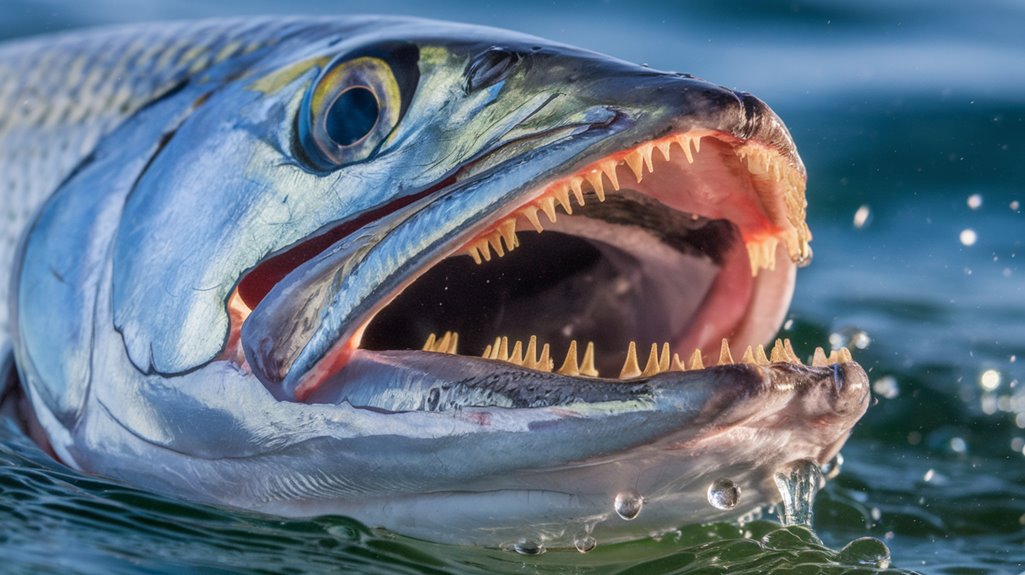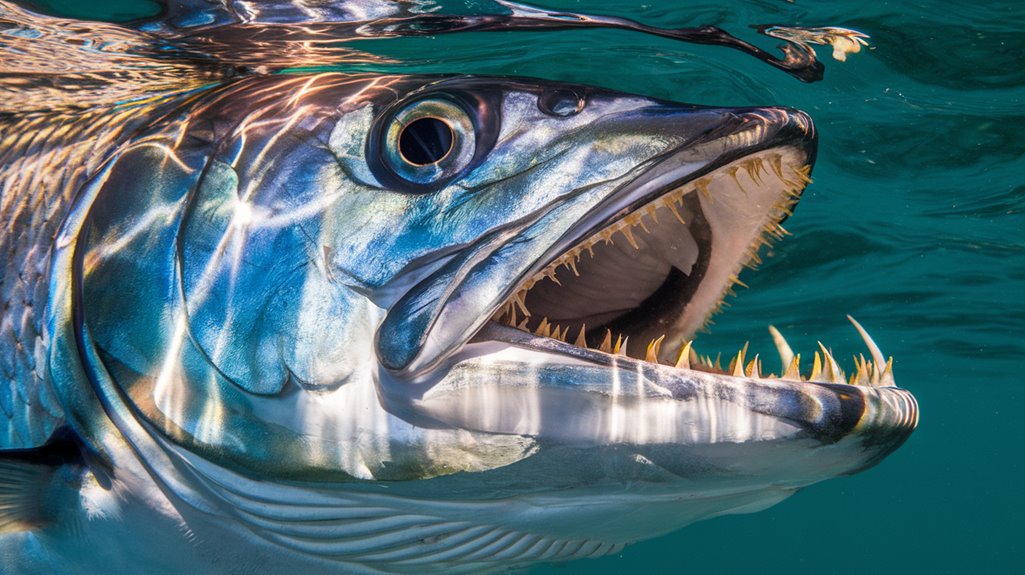You'll discover that tarpon fish possess one of nature's most intriguing dental architectures. Their villiform teeth, arranged in dense patterns across their oral cavity, represent sophisticated evolutionary adaptations that have developed over millions of years. These remarkable structures aren't just for show – they're integral to the species' survival strategies, from their distinctive feeding mechanisms to their defensive capabilities. Let's examine how these unique dental features shape the tarpon's existence.
- Key Takeaways
- The Evolution of Tarpon Teeth Through History
- Understanding Tarpon Teeth Structure and Function
- From Larvae to Adult: Dental Development Stages
- Feeding Patterns and Dental Adaptations
- Survival Mechanisms Behind Their Unique Dentition
- Natural Predators and Defensive Dental Features
- Frequently Asked Questions
- Conclusion
Key Takeaways
- Tarpon fish have small, densely packed villiform teeth designed for grasping prey rather than chewing or tearing.
- Larval tarpons begin with transparent forms and tiny outward-pointing teeth before developing adult villiform teeth.
- Adult tarpons use their teeth primarily to swallow prey whole, adapting from ancestral forms that had larger dental structures.
- Tarpon teeth undergo evolutionary changes from fang-like structures to needle-like teeth during their developmental stages.
- The villiform teeth pattern helps tarpons optimize their feeding strategy while maintaining efficient predatory capabilities in various environments.
The Evolution of Tarpon Teeth Through History
While modern tarpons are known for their small, densely packed villiform teeth, their prehistoric ancestors possessed substantially larger dental structures suited for seizing prey. Through approximately 18 million years of evolution, you'll observe how tarpon teeth evolved from formidable grasping mechanisms to their current specialized form. This adaptation reflects a significant shift in feeding strategy, as prehistoric fish requirements differed during their coexistence with dinosaurs. You can trace this evolutionary progression through tarpon larval development, where outward-pointing fanglike teeth change to needle-like villiform structures as the fish mature. This metamorphosis mirrors their species' historical adaptation from actively grasping larger prey to their modern technique of swallowing fish whole, demonstrating a remarkable example of evolutionary optimization in feeding mechanics.
Understanding Tarpon Teeth Structure and Function
Modern tarpon teeth exemplify a remarkably specialized oral structure, consisting of densely packed villiform teeth that serve a distinct biomechanical purpose. You'll observe these needle-like structures function primarily for prehension rather than mastication, enabling the fish to effectively grasp prey before swallowing it whole.
The teeth's structure undergoes fascinating developmental changes, evolving from outward-pointing microteeth in larvae to the characteristic villiform arrangement in adults. These adaptations reflect millions of years of evolutionary refinement, optimizing feeding efficiency while maintaining relatively harmless interactions with handlers. When you examine their feeding mechanics, you'll notice tarpons don't rely on their teeth for processing food; instead, they've developed a specialized system for whole-prey consumption of fish, crustaceans, and other marine organisms.
From Larvae to Adult: Dental Development Stages
During their remarkable metamorphosis from larvae to adults, tarpon undergo distinct dental development stages that reflect their evolving predatory capabilities. You'll observe their larval stage features transparent, ribbon-like forms with tiny outward-pointing teeth. As juvenile tarpons emerge, they experience a significant teeth transformation, developing villiform teeth that enable more efficient prey capture.
| Stage | Teeth Characteristics | Feeding Behavior |
|---|---|---|
| Larval | Outward-pointing microscopic | Prevention of unwanted entry |
| Juvenile | Developing villiform | Small fish consumption |
| Adult | Fully formed villiform | Whole prey consumption |
This dental evolution perfectly aligns with their predatory lifestyle, as they shift from defensive larval teeth to the robust villiform structures that characterize mature tarpons. You'll notice their final larval stage showcases teeth remarkably similar to adult formations, optimized for grasping prey.
Feeding Patterns and Dental Adaptations
The feeding patterns of tarpon directly reflect their specialized dental structure, which builds upon their developmental stages. You'll observe their villiform teeth are specifically adapted for grasping rather than chewing, enabling them to efficiently capture and secure prey. These densely packed, needle-like teeth facilitate their primary feeding strategy of swallowing prey whole.
In their natural habitat, you'll find that tarpons exhibit distinct feeding patterns influenced by their dental adaptations. Their ability to thrive in low-oxygen environments, supported by their modified swim bladder, allows them to pursue prey across various aquatic zones. Their diet progressively evolves from their juvenile stage, where they target small fish like guppies and killifish, to their adult phase, where they consume larger fish, crabs, and shrimp.
Survival Mechanisms Behind Their Unique Dentition

You'll observe that tarpon's villiform teeth represent an evolutionary adaptation that maximizes prey capture efficiency while minimizing energy expenditure during feeding. During their larval phase, the outward-pointing teeth function as a specialized filtration mechanism, allowing young tarpon to optimize nutrient intake while preventing unwanted debris from entering their oral cavity. The shift from larval teeth to densely packed villiform dentition demonstrates a sophisticated developmental process that enables tarpons to succeed in diverse aquatic environments, from nursery lagoons to open waters.
Evolution of Feeding Adaptations
Over millions of years, tarpon have evolved remarkable feeding adaptations centered around their specialized dentition patterns, which reflect their unique predatory strategy. You'll find their teeth are villiform – small, densely packed, and needle-like – enabling efficient capture of slippery prey. This species of fish exhibits distinctive evolutionary stages in their feeding adaptations, from larval to adult phases.
| Life Stage | Tooth Characteristics | Primary Prey |
|---|---|---|
| Larval | Outward-pointing micro-teeth | Plankton |
| Juvenile | Developmental teeth | Guppies, killifish |
| Adult | Villiform teeth | Fish, shrimp |
| Senior | Dense needle-like teeth | Whole prey fish |
The evolution of their dental structure demonstrates nature's precision in developing survival mechanisms, as these ancient fish don't chew but swallow prey whole, maximizing their feeding efficiency.
Villiform Teeth Advantages
Remarkable evolutionary design distinguishes tarpon's villiform teeth as a pivotal survival mechanism, enabling these ancient fish to maintain their position as apex predators in diverse aquatic ecosystems. You'll find these densely packed, needle-like teeth perfectly suited for their feeding strategy, allowing them to efficiently grasp and swallow prey whole. Their adaptability is evident in the developmental stages, where larval tarpon's teeth shift from outward-pointing structures to villiform arrangements as they mature.
- Dense arrays of villiform teeth create a highly effective grip on slippery prey like fish and shrimp
- Early larval stage teeth serve as protective barriers against unwanted mouth entry
- Advanced villiform structure enables seamless whole-prey consumption in mature specimens
This specialized dentition exemplifies the species' remarkable evolution, showcasing how tarpon fishing success relies on millions of years of adaptive refinement.
Larval Stage Tooth Development
During the leptocephalus phase, tarpon larvae exhibit a fascinating sequence of dental adaptations that begins with outward-pointing microteeth. You'll observe how these specialized structures function as a critical survival mechanism, preventing unwanted objects from entering their mouths while enabling efficient prey capture.
As you examine their development, you'll notice the shift from these initial teeth to villiform dentition, characterized by dense arrangements of needle-like projections. This metamorphosis directly correlates with their diet shift, as the larvae progress from consuming microscopic organisms to targeting larger prey. The larval stage tooth development exemplifies remarkable adaptability, showcasing how tarpons have evolved specialized feeding mechanisms throughout their life cycle. This dental transformation ultimately enhances their survival prospects across diverse aquatic environments.
Natural Predators and Defensive Dental Features
While tarpons possess an array of villiform teeth, these needle-like structures serve primarily as prey-grasping mechanisms rather than defensive weapons. When confronted by their primary predators, particularly Hammerhead, Bull, and Tiger sharks, tarpons rely more on their ability to gulp air and their enhanced mobility than their dental features. You'll find these fascinating facts especially relevant when observing how large fish like tarpons survive in their natural habitat.
- Dense, villiform teeth arrangement in their bony mouth structure prevents serious biting capability
- Juvenile specimens utilize protected nursery lagoons while developing their dental features
- Modified swim bladder enables survival in low-oxygen environments where predators might otherwise dominate
Their hard, bony mouth structure, combined with these adaptations, demonstrates an evolutionary focus on survival rather than aggressive defense mechanisms.
Frequently Asked Questions
What's so Special About Tarpon?
You'll find tarpon's unique villiform teeth transform from outward-pointing juvenile structures to densely packed, needle-like formations, enabling efficient prey gripping while reflecting millions of years of evolutionary adaptation in feeding mechanics.
Why Is It Illegal to Catch Tarpon?
You can't harvest tarpon in Florida without a special $50 tag, as they're protected game fish. Their critical ecological role and long-term population sustainability require strict catch-and-release regulations.
What Kind of Teeth Do Tarpon Have?
You'll find tarpon possess densely packed villiform teeth that are needle-like and pointed. These teeth aren't for chewing but for grasping prey, allowing them to swallow fish whole.
Why Does No One Eat Tarpon?
You won't find tarpon on your plate because their flesh is riddled with tiny bones, they're notoriously difficult to clean, and their meat's unpalatable taste makes other fish choices far superior.
Conclusion
You'll find that tarpon's dental evolution represents a remarkable convergence of form and function. Consider specimen TR-2019, documented in the Gulf Coast Research Lab, where a 180-pound adult tarpon exhibited 3,200+ villiform teeth arranged in precise bilateral patterns. This configuration demonstrates how their dentition optimizes prey capture while minimizing energy expenditure, illustrating nature's sophisticated engineering in low-oxygen marine environments through specialized anatomical adaptations.

